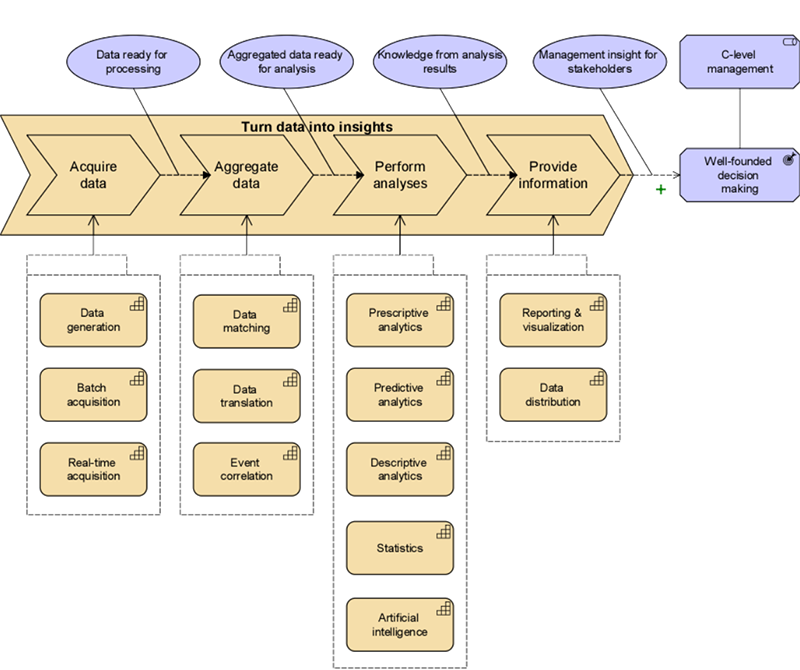In recent years, the concept of ‘value stream’ has become increasingly popular. It is a useful element in the toolbox of business architects, and is advocated in, for example, the Open Group Guide to Value Streams and the BIZBOK® from the Business Architecture Guild®. Though ArchiMate® has had a value mapping element since its inception, until now it does not have a value stream element. In this blog we propose to add a value stream element to ArchiMate in a way that supports approaches such as those described in the Value Stream Guide and the BIZBOK, is coherent with the language structure, and minimizes the impact on the rest of the language.
We define a value stream as follows:
A value stream is a sequence of value-adding activities that achieve
a specific result that is of value to a stakeholder.
A value stream describes how an enterprise organizes its activities to create value. As described in the Open Group Guide to Value Streams, a key principle of value streams is that value is always defined from the perspective of the stakeholder – the customer, end-user, or recipient of the product, service, or deliverable produced by the work. The value obtained is in the eye of the beholder; it depends more on the stakeholder’s perception of the worth of the product, service, outcome, or deliverable than on its intrinsic value; i.e., the cost to produce. This is modeled in the ArchiMate language using the value element.
Resources can be assigned to value streams and capabilities can serve (i.e., enable) a value stream. This supports the common technique of capability – value stream cross-mapping, where you identify which capabilities the enterprise needs or uses to support the stages in a value stream.
Value streams can be defined at different levels of the organization, e.g. at the enterprise level, business unit level, or department level, and they may extend into the enterprise ecosystem , where partners, suppliers, customers and others play a role in the value creation. Value streams can be a composition or aggregation of sub-streams, usually called value (stream) stages, where each stage should have a clear value contribution of its own. These stages are typically related using flow relationships to model the flow of value between them. Note that since in ArchiMate, all elements can be composed of or aggregate sub-elements of the same type, we do not need to add a separate value stage element to the language, as mentioned in the Value Stream Guide and the BIZBOK; this can simply be represented by such a composition or aggregation.
Business processes and possibly other core behavior elements typically realize a value stream, for example if parts of it are automated. The stages in a value stream provide a framework for organizing and defining business processes, but different parts of the organization may have their own implementations of business processes to realize the same value stream stage. Conversely, one business process may realize multiple stages in a value stream.
Importantly, a value stream may seem very similar to an end-to-end business process, so why add this to the ArchiMate language? The main reason is that these two concepts are defined at different abstraction levels and serve separate purposes. A business process describes the (time-ordered) sequence of behaviors required to create some result for an individual case, and it may describe alternative paths and decision points (modeled with junctions). In contrast, a value stream focuses on the overall value-creating behavior from the perspective of the importance, worth, or usefulness of what is produced, and is not a description of time-ordered tasks for individual cases.
Adding a value stream concept also leads to a neat symmetry in the language. Value streams and capabilities reflect an organization’s business model and value proposition, whereas business processes and business functions reflect its operating model . At their respective abstraction levels, value streams and business processes both represent the ‘enterprise in motion’, whereas capabilities and business functions both describe the ‘enterprise at rest’.
The example below shows a model of a data analysis value stream from a business intelligence case study. Between the stages of the value stream, we see the value flows with associated value items, and at the end the business outcome of ‘well-founded decision making’ that this value stream realizes for a particular stakeholder. Each stage in the value stream requires a number of capabilities, shown below the stages and also exhibiting how you can use the improved grouping concept in ArchiMate 3.0 to model this cross-mapping efficiently.

Model of a data analysis value stream.
Since our customers confirmed the usefulness of this value stream concept, BiZZdesign has already added support for it to Enterprise Studio (as you can see from the example above), so you can start modeling your value streams today .
We have also submitted a proposal along these lines to the ArchiMate Forum of The Open Group. Moreover, we will soon release more advanced support, for example for the creation of Business Outcome Journey Maps and Ecosystem Modeling. Stay tuned for more!